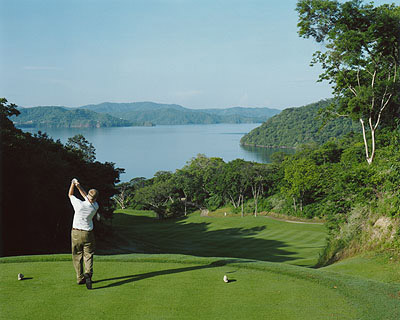‘Show Me the Monkeys!’
That is my overriding desire as I step to the first tee of the dazzling golf course at the Four Seasons Resort Costa Rica at Peninsula Papagayo. Instead, who do I see astride a log in front of the tee but Petey the Iguana.
Then-director of golf Rob Oosterhuis makes the introductions. Petey is a huge mottled specimen, imperious of eye, a direct link to the dinosaurs. He is impressive, and trees he can climb, but a monkey he’s not.
And so I concentrate instead on an engineering marvel seemingly airlifted by Arnold Palmer and his design team into a tropical forest on hilly land high above the hotel. The layout, challenging but fun, doesn’t play quite as tough as it looks, a neat trick. There’s plenty of room off the tee, and the routing, by some miracle, has no arduous uphill holes despite the topsy-turvy terrain.
Like Arnie himself on opening day in 2004, I pause to take in the view from the third tee, appropriately named ‘Buena Vista.’ From this exalted pinnacle I can survey the bay on one side and the Pacific on the other, the rocky bluffs rising from the surging sea for 60 miles. Even a jaded campaigner would pronounce it the finest panorama in all of Latin America.

Teeing off on the stellar par-four sixth hole
But it is not the signature hole. That distinction belongs to No. 6, a stunning par four that plummets 200 feet from the tee to a winding ribbon of fairway laid into the V-shaped valley far below. I’m not a crusher, but I caught my drive flush and counted to ‘10’ before it hit the ground, the tiny white ball pinned to the deep blue sea before dropping to earth. On the way down the hill, I scout the forest left and right for signs of monkeys, only to see flocks of green parrots flitting from tree to tree. Only.
The resort’s par-five ninth hole is a throwback, a straightaway, no-frills design and one of the few flat holes on the course. What is has on either side of the fairway are huge specimen trees with massive trunks and giant crowns. It is summer, the dry season, and most of the trees are bare—except for the last one on the left near the ravine, a towering Guanacaste tree that somehow is still green, a fact not lost on the band of howler monkeys that climb and leap effortlessly from branch to branch to eat its leaves.
Rob parks the cart a short distance from the tree and points up. A large male carries a baby no bigger than a teacup on its back, the smaller females chattering away and the acrobatic juveniles using their long arms and tails to defy gravity. There are roughly 15 monkeys in this social, well-organized clan. Animal planet at last! By the time I’m handed a chilled, citrus-infused towel and led to the clubhouse, which looks like a cross between a flying saucer and a conch shell, I have been charmed by the course and mesmerized by the monkeys. Or was it the other way around?
